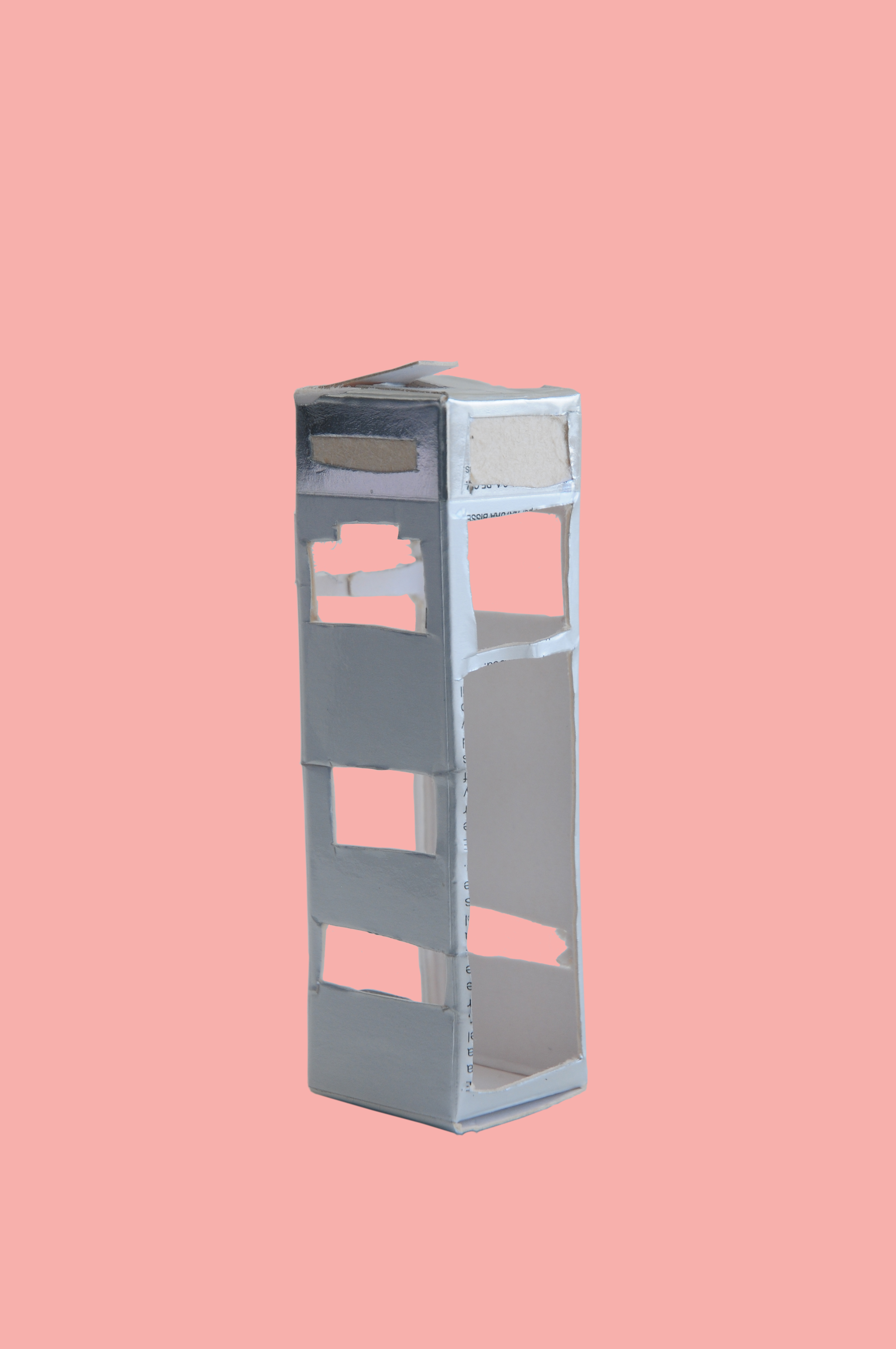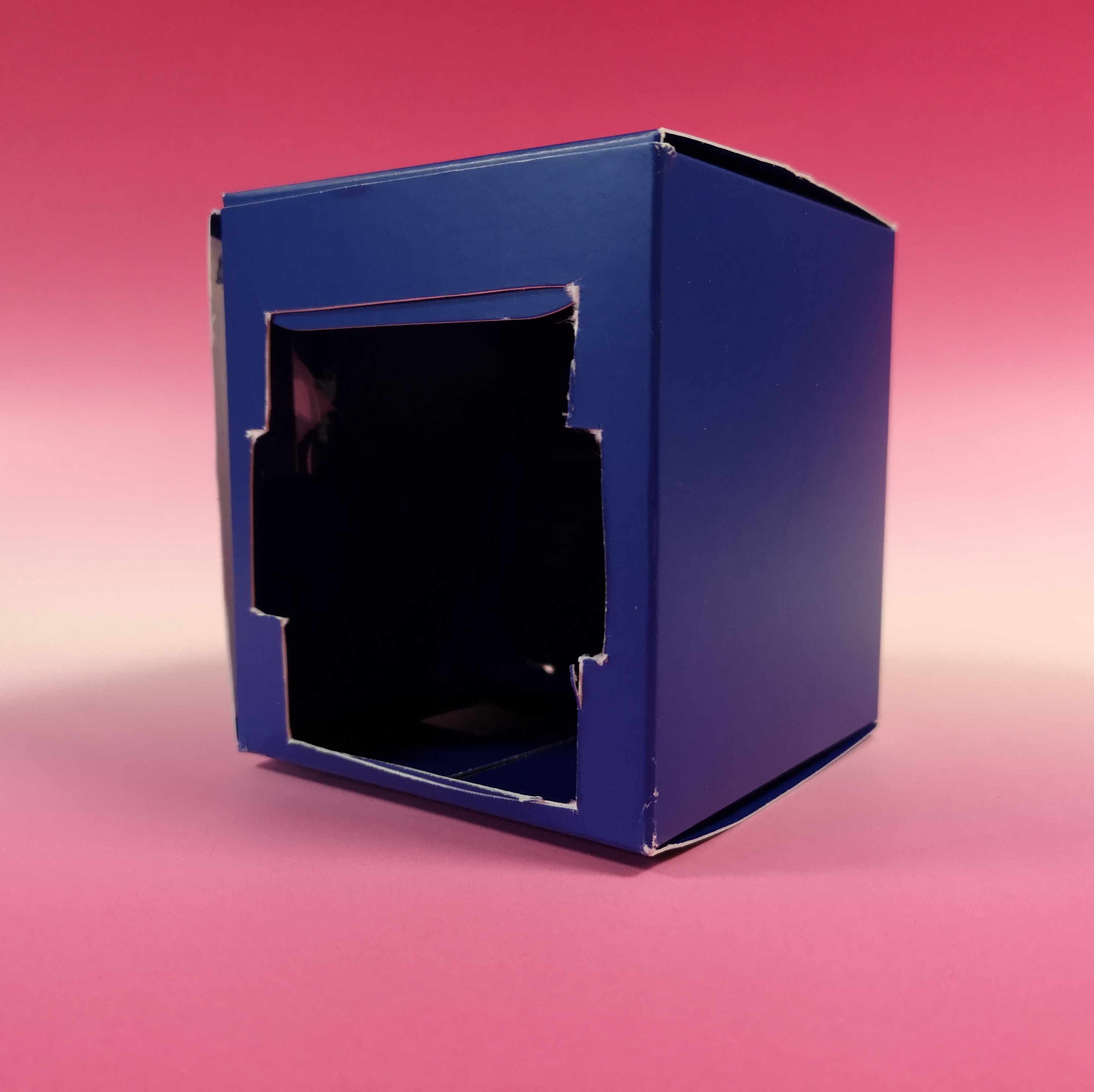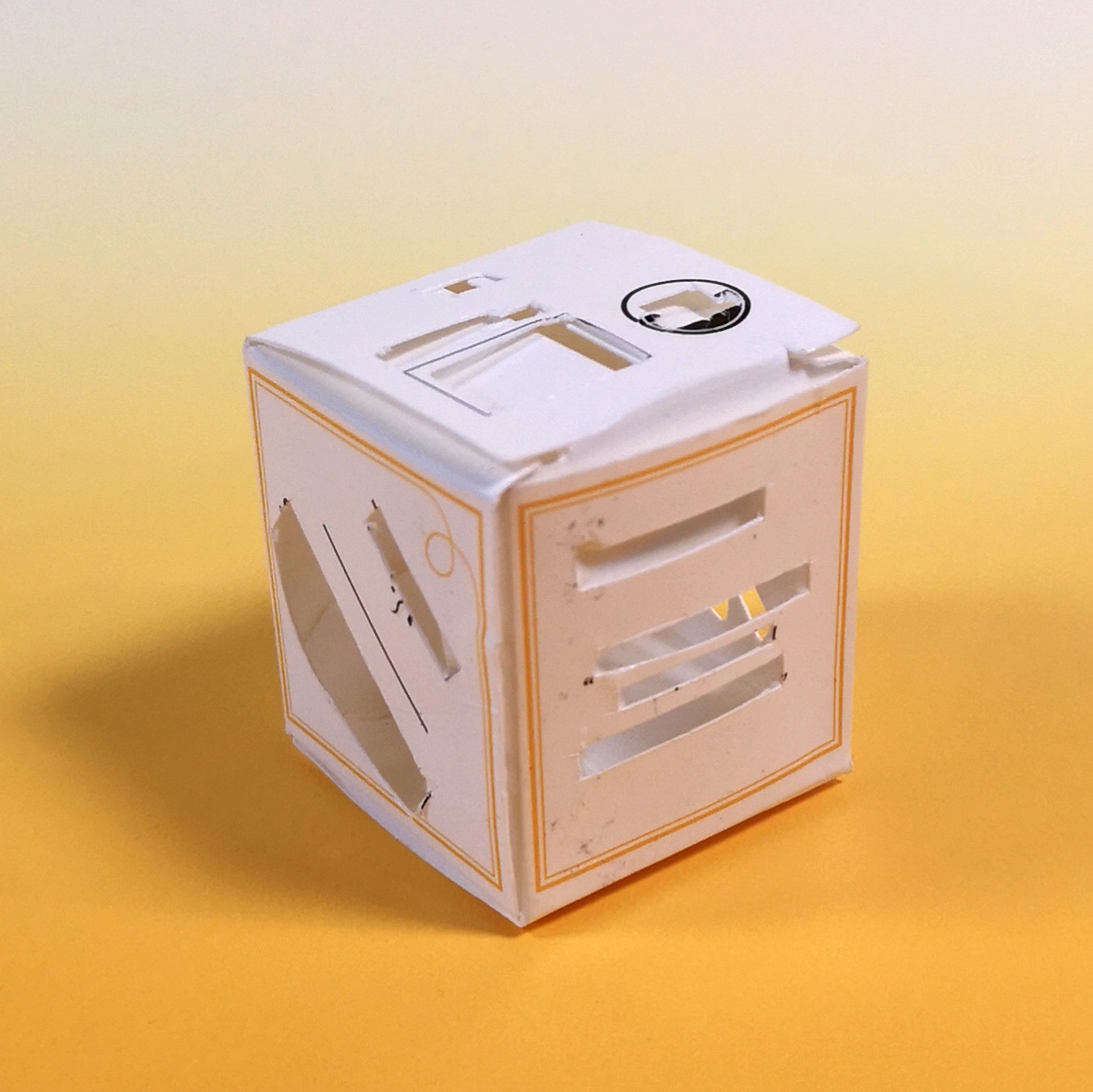CONTAINNERS
2005 present. Boxes.



![1/6]()
![2/6]()
![3/6]()
![4/6]()
![5/6]()
![6/6]()
(CAT)
Un contenidor és una eina bàsica. Consisteix en qualsevol dispositiu amb un espai tancat del tot o parcialment que es pot utilitzar per contenir, emmagatzemar-hi objectes de transport o materials. Les coses que es mantenen a l'interior d'un contenidor estan protegides dins de la seva estructura.
Però també és una manera de presentar el que hi ha dins, de vendre-ho o de regalar-ho. L’art d’embolicar o el packaging són autèntiques disciplines. Per a fer aquesta sèrie s’ha pres com a suport capses de diferents productes comercials (perfums, productes de neteja, envasos de ....) provinents del mon de la quotidianitat. Capses pensades per a presentar-nos un tipus de producte, on la informació del que contenen s’ha anat distribuint, segons la lògica del packaging, per totes les cares de l’envàs.
Hem intervingut aquestes capses extraient tota la informació, en totes i cadascuna de les cares de l’objecte, deixant a la vista un envàs buit d’informació textual i publicitària. Els forats permeten a l’envàs respirar i transformar-se en un espai obert, on podem veure el seu interior i l’entorn on està situat. L’envàs descontextualitzat del seu pes informatiu es transforma i es percep d’una forma nova. És un espai escultòric i d’alguna manera també arquitectònic vàlid per ell mateix. Els containners ens transporten a la percepció d’una bellesa nua i fresca. Deixen circular la mirada de fora a dins -d’aquí la modificació de la paraula, de container a conta_inner (interior) perquè el contenidor esdevingui contingut, el dins passi a fora i el fora esdevingui el dins.
Els containners ens remeten al forat, forat finestra, forats del cos, forats a la natura. El forat com a espai per mirar, per comunicar, per traspassar. El forat és un espai obert que permet una visualització de l’obra com espai obert, obra oberta, que no ens exigeix relats. Són objectes llindars.
“El vacío vacía al que mira en lo mirado. Se ejercita un ver que en cierto modo es objetivo, que se hace objeto, un ver “amistoso”, que deja ser. (…) el vacío es lo abierto, que permite una compenetración recíproca. Produce amabilidad. En un ente se refleja el todo. Y el todo habita en un ente. Nada se retira a un aislado ser para sí. Todo fluye. Las cosas pasan las unas a las otras.”
(Byung-Chul Han, Filosofia del budismo zen)
“Y liberarse humanamente es reducirse; ganar espacio, el “espacio vital”, lleno por la inflación de su propio ser. (…) Reducir lo humano llevará consigo, inexorablemente, dejar sitio a lo divino, en esa forma que se hace posible que lo divino se insinúe y aparezca como presencia y aún como ausencia que nos devora. (…) reducirse, entrar en razón, es también recobrarse.
En su situación inicial el hombre no se siente solo. A su alrededor no hay un espacio vital libre, sino todo lo contrario. Lo que le rodea está lleno. Lleno y no sabe de qué.”
(M.Zambrano, El hombre y lo divino).



(ESP)
Un contenedor es una herramienta básica. Consiste en cualquier dispositivo con un espacio cerrado total o parcialmente que se puede utilizar para contener y almacenar objetos de transporte o materiales. Las cosas que se mantienen en el interior de un contenedor están protegidas por su estructura.
Pero también es una manera de presentar lo que hay dentro, de venderlo o de regalarlo. El arte de envolver o el packaging son auténticas disciplinas. Para hacer esta serie se ha tomado como soporte cajas de diferentes productos comerciales (perfumes, productos de limpieza, envases de…) provenientes del mundo de la cotidianeidad. Cajas pensadas para presentarnos un tipo de producto, donde la información de lo que contienen se ha ido distribuyendo, según la lógica del packaging, por todas las caras del envase.
Hemos intervenido estas cajas extrayendo toda la información, en todas y cada una de las caras del objeto, dejando a la vista un envase vacío de información textual y publicitaria. El agujero permite que el envase respire y se transforme en un espacio abierto, donde podemos ver su interior y el entorno donde está situado. El envase descontextualizado de su peso informativo se transforma y se percibe de una forma nueva. Es un espacio escultórico, y de alguna manera también arquitectónico, válido por sí mismo. Los containners nos transportan a la percepción de una belleza desnuda y fresca. Dejan circular la mirada desde fuera hacia dentro; de aquí la modificación de la palabra, de container a conta_inner (interior) porque el contenedor se convierte en contenido, el dentro pasa afuera y el fuera se convierte en él dentro.
Los containners nos remiten al agujero, agujero-ventana, agujeros del cuerpo, agujeros en la naturaleza; el agujero como espacio para mirar, para comunicar, para traspasar. El agujero es un espacio abierto que permite una visualización de la obra como espacio abierto, obra abierta, que no nos exige relatos. Son objetos-umbrales.
“El vacío vacía al que mira en lo mirado. Se ejercita un ver que en cierto modo es objetivo, que se hace objeto, un ver “amistoso”, que deja ser. (…) el vacío es lo abierto, que permite una compenetración recíproca. Produce amabilidad. En un ente se refleja el todo. Y el todo habita en un ente. Nada se retira a un aislado ser para sí. Todo fluye. Las cosas pasan las unas a las otras.”
(Byung-Chul Han, Filosofia del budismo zen)
“Y liberarse humanamente es reducirse; ganar espacio, el “espacio vital”, lleno por la inflación de su propio ser. (…) Reducir lo humano llevará consigo, inexorablemente, dejar sitio a lo divino, en esa forma que se hace posible que lo divino se insinúe y aparezca como presencia y aún como ausencia que nos devora. (…) reducirse, entrar en razón, es también recobrarse.
En su situación inicial el hombre no se siente solo. A su alrededor no hay un espacio vital libre, sino todo lo contrario. Lo que le rodea está lleno. Lleno y no sabe de qué.”
(M.Zambrano, El hombre y lo divino)
Un contenedor es una herramienta básica. Consiste en cualquier dispositivo con un espacio cerrado total o parcialmente que se puede utilizar para contener y almacenar objetos de transporte o materiales. Las cosas que se mantienen en el interior de un contenedor están protegidas por su estructura.
Pero también es una manera de presentar lo que hay dentro, de venderlo o de regalarlo. El arte de envolver o el packaging son auténticas disciplinas. Para hacer esta serie se ha tomado como soporte cajas de diferentes productos comerciales (perfumes, productos de limpieza, envases de…) provenientes del mundo de la cotidianeidad. Cajas pensadas para presentarnos un tipo de producto, donde la información de lo que contienen se ha ido distribuyendo, según la lógica del packaging, por todas las caras del envase.
Hemos intervenido estas cajas extrayendo toda la información, en todas y cada una de las caras del objeto, dejando a la vista un envase vacío de información textual y publicitaria. El agujero permite que el envase respire y se transforme en un espacio abierto, donde podemos ver su interior y el entorno donde está situado. El envase descontextualizado de su peso informativo se transforma y se percibe de una forma nueva. Es un espacio escultórico, y de alguna manera también arquitectónico, válido por sí mismo. Los containners nos transportan a la percepción de una belleza desnuda y fresca. Dejan circular la mirada desde fuera hacia dentro; de aquí la modificación de la palabra, de container a conta_inner (interior) porque el contenedor se convierte en contenido, el dentro pasa afuera y el fuera se convierte en él dentro.
Los containners nos remiten al agujero, agujero-ventana, agujeros del cuerpo, agujeros en la naturaleza; el agujero como espacio para mirar, para comunicar, para traspasar. El agujero es un espacio abierto que permite una visualización de la obra como espacio abierto, obra abierta, que no nos exige relatos. Son objetos-umbrales.
“El vacío vacía al que mira en lo mirado. Se ejercita un ver que en cierto modo es objetivo, que se hace objeto, un ver “amistoso”, que deja ser. (…) el vacío es lo abierto, que permite una compenetración recíproca. Produce amabilidad. En un ente se refleja el todo. Y el todo habita en un ente. Nada se retira a un aislado ser para sí. Todo fluye. Las cosas pasan las unas a las otras.”
(Byung-Chul Han, Filosofia del budismo zen)
“Y liberarse humanamente es reducirse; ganar espacio, el “espacio vital”, lleno por la inflación de su propio ser. (…) Reducir lo humano llevará consigo, inexorablemente, dejar sitio a lo divino, en esa forma que se hace posible que lo divino se insinúe y aparezca como presencia y aún como ausencia que nos devora. (…) reducirse, entrar en razón, es también recobrarse.
En su situación inicial el hombre no se siente solo. A su alrededor no hay un espacio vital libre, sino todo lo contrario. Lo que le rodea está lleno. Lleno y no sabe de qué.”
(M.Zambrano, El hombre y lo divino)
(ENG)
A container is a basic tool that consists in any device that creates a partially or totally closed space that can be used for containment, storage and the transport of objects or materials. The things kept in the interior of a container are protected by being inside its structure.
However, it is also a way to present what’s inside, to sell it or give it away. The art of wrapping or packaging are authentic trades. To create this series, boxes belonging to different commercial products (perfumes, cleaning products, packing of...) from the world of daily routines were used as a canvas. Boxes thought to present a type of product, where the information of what it contains has been distributed, according to the logic of packaging, over all the faces of the container.
These boxes have been intervened on, extracting all the information, on each and every face of the object, leaving a package empty of publicity and textual information. The holes allow the packet to breathe and transform into an open space, where we can see its interior and the environment in which it is situated. The package, decontextualized from its informative weight, is transformed and is perceived in a new way. It is a sculptural and, in some way, architectural space valid on its own. The containners transport us to the perception of a nude and fresh beauty. Letting the gaze to roam from outside to within –from here the modification of the word, from container to conta_inner because the container becomes the content, the inside comes out and the outside becomes the inside.
The containners take us to the hole, hole-window, holes of the body, hole in nature. The hole as a space to look, to communicate, to transfer. The hole is an open space that allows a visualisation of the artwork as an open space, open work, that doesn’t call for stories. They are threshold objects.
“The void empties whoever looks at what is looked at. It exercises a view that in a way is objective, which becomes an object, a “friendly” view, that lets be. (...) el void is what is open, what allows a reciprocal rapport. It produces amiability. In a being that reflects everything. And everything inhabits a being. Nothing retires to an isolated being for itself. Everything flows. Things pass from one to another.”
(Byung-Chul Han, Philosophy of Zen Buddhism)
“To liberate oneself humanely is to reduce oneself; to gain space, “vital space”, filled by the inflation of the being. (...) To reduce the human with lead to, inexorably, leaving space for the divine, in the form that makes it possible for the divine to insinuate and appear as a presence and still as an absence that devours us. (...) to reduce, to see reason, is to also recover. In his initial situation, man does not feel alone. There is no free vital space surrounding him, rather the complete opposite. His surroundings are full. Full and he doesn’t know of what.”
(M. Zambrano, Man and the Divine)
A container is a basic tool that consists in any device that creates a partially or totally closed space that can be used for containment, storage and the transport of objects or materials. The things kept in the interior of a container are protected by being inside its structure.
However, it is also a way to present what’s inside, to sell it or give it away. The art of wrapping or packaging are authentic trades. To create this series, boxes belonging to different commercial products (perfumes, cleaning products, packing of...) from the world of daily routines were used as a canvas. Boxes thought to present a type of product, where the information of what it contains has been distributed, according to the logic of packaging, over all the faces of the container.
These boxes have been intervened on, extracting all the information, on each and every face of the object, leaving a package empty of publicity and textual information. The holes allow the packet to breathe and transform into an open space, where we can see its interior and the environment in which it is situated. The package, decontextualized from its informative weight, is transformed and is perceived in a new way. It is a sculptural and, in some way, architectural space valid on its own. The containners transport us to the perception of a nude and fresh beauty. Letting the gaze to roam from outside to within –from here the modification of the word, from container to conta_inner because the container becomes the content, the inside comes out and the outside becomes the inside.
The containners take us to the hole, hole-window, holes of the body, hole in nature. The hole as a space to look, to communicate, to transfer. The hole is an open space that allows a visualisation of the artwork as an open space, open work, that doesn’t call for stories. They are threshold objects.
“The void empties whoever looks at what is looked at. It exercises a view that in a way is objective, which becomes an object, a “friendly” view, that lets be. (...) el void is what is open, what allows a reciprocal rapport. It produces amiability. In a being that reflects everything. And everything inhabits a being. Nothing retires to an isolated being for itself. Everything flows. Things pass from one to another.”
(Byung-Chul Han, Philosophy of Zen Buddhism)
“To liberate oneself humanely is to reduce oneself; to gain space, “vital space”, filled by the inflation of the being. (...) To reduce the human with lead to, inexorably, leaving space for the divine, in the form that makes it possible for the divine to insinuate and appear as a presence and still as an absence that devours us. (...) to reduce, to see reason, is to also recover. In his initial situation, man does not feel alone. There is no free vital space surrounding him, rather the complete opposite. His surroundings are full. Full and he doesn’t know of what.”
(M. Zambrano, Man and the Divine)